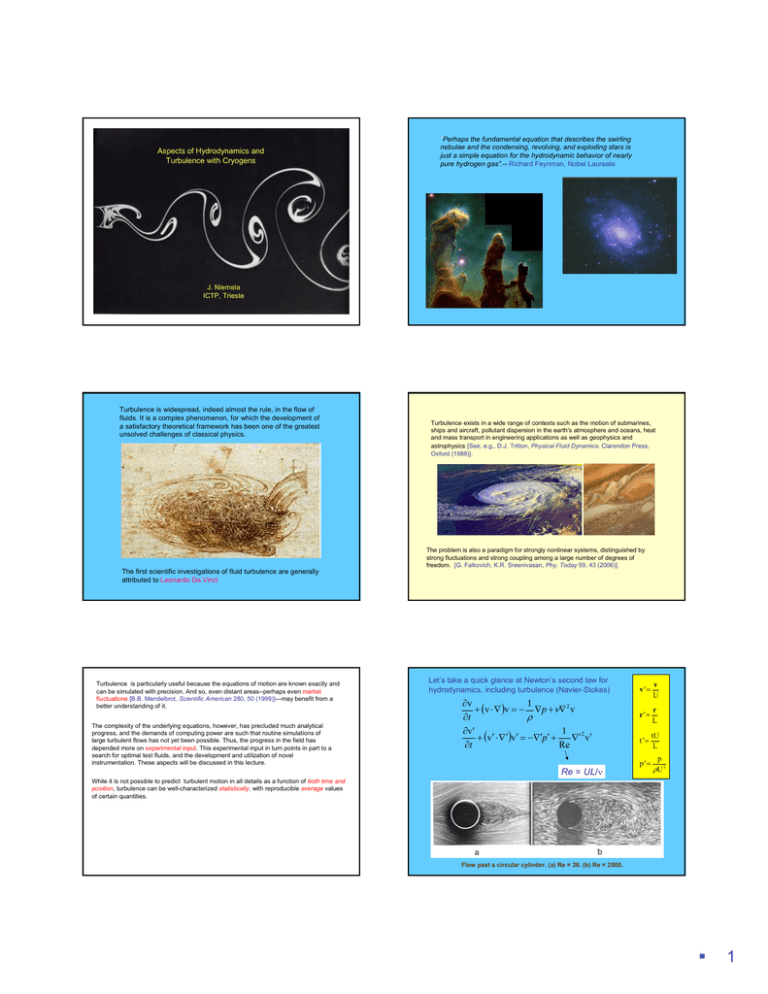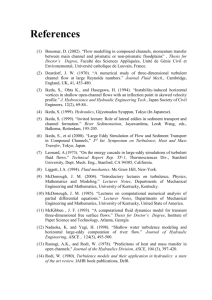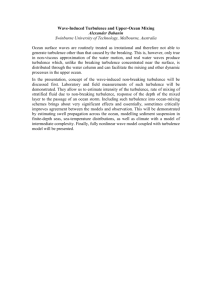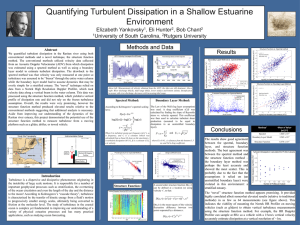Document 10390049
advertisement

Aspects of Hydrodynamics and Turbulence with Cryogens “Perhaps the fundamental equation that describes the swirling nebulae and the condensing, revolving, and exploding stars is just a simple equation for the hydrodynamic behavior of nearly pure hydrogen gas”.-- Richard Feynman, Nobel Laureate J. Niemela ICTP, Trieste Turbulence is widespread, indeed almost the rule, in the flow of fluids. It is a complex phenomenon, for which the development of a satisfactory theoretical framework has been one of the greatest unsolved challenges of classical physics. The first scientific investigations of fluid turbulence are generally attributed to Leonardo Da Vinci. Turbulence is particularly useful because the equations of motion are known exactly and can be simulated with precision. And so, even distant areas--perhaps even market fluctuations [B.B. Mandelbrot, Scientific American 280, 50 (1999)]---may benefit from a better understanding of it. The complexity of the underlying equations, however, has precluded much analytical progress, and the demands of computing power are such that routine simulations of large turbulent flows has not yet been possible. Thus, the progress in the field has depended more on experimental input. This experimental input in turn points in part to a search for optimal test fluids, and the development and utilization of novel instrumentation. These aspects will be discussed in this lecture. Turbulence exists in a wide range of contexts such as the motion of submarines, ships and aircraft, pollutant dispersion in the earth's atmosphere and oceans, heat and mass transport in engineering applications as well as geophysics and astrophysics [See, e.g., D.J. Tritton, Physical Fluid Dynamics. Clarendon Press, Oxford (1988)]. The problem is also a paradigm for strongly nonlinear systems, distinguished by strong fluctuations and strong coupling among a large number of degrees of freedom. [G. Falkovich, K.R. Sreenivasan, Phy. Today 59, 43 (2006)]. Let’s take a quick glance at Newton’s second law for hydrodynamics, including turbulence (Navier-Stokes) ∂v 1 + (v ⋅ ∇ )v = − ∇p + ν∇ 2 v ∂t ρ 1 ∂v′ + (v′ ⋅ ∇′)v′ = −∇′p′ + ∇′ 2 v′ ∂t Re Re = UL/ν v' = v U r' = r L t' = tU L p' = p ρU 2 While it is not possible to predict turbulent motion in all details as a function of both time and position, turbulence can be well-characterized statistically, with reproducible average values of certain quantities. Flow past a circular cylinder. (a) Re = 26. (b) Re = 2000. 1 The Reynolds number is a manifestation of dynamical similarity. That is, if we consider two simple flows that are geometrically similar, then they are dynamically identical if the corresponding Re is the same for both, regardless of the specific velocities, lengths and fluid viscosities involved. Q. Two flows are dynamically similar if--- Matching such parameters between laboratory testing of a model and the actual full-scale object (the prototype) is the principle upon which aerodynamic modeltesting is based. a) the fluids have the same kinematic viscosity b) the flows have the same Re c) the flows have large Re>>1 Above left: wake behind a flat plate inclined 45 degrees to the direction of the flow (left to right). Above right: A foundered ship in the sea inclined 45 degrees to the direction of the current. Where does the injected energy go? Making Turbulence in the laboratory Richardson Energy Cascade Traditionally, large arrays of wake-producing “cylinders”-- such as we saw above-are placed in the flow in order to generate something approaching homogeneous and isotropic turbulence. grid flow Eddies produced by flow (e.g., through a grid at length scale M= mesh size) Cascade of energy in inertial range: local transfer of energy (due to nonlinear inertial term in NS eqn.). Initial turbulent forcing at scale of the mesh size M. Viscous dissipation at small scales for which local Re~1. For “inertial range” between large energy injection scale L and the smallest dissipation scale η the energy spectrum (in k-space) is E(k) = C ε2/3 k-5/3 where ε is the rate of energy transfer per unit mass. (E(k) is the energy contained in the wavenumber shell between k and k+dk. Here, flow at speed U through a grid of crossed tines with mesh size M, generates a turbulent wake, injecting kinetic energy initially on that scale. Smallest scale given by η ∼ LRe-3/4. If there are any universal statistical properties of turbulence, it is reasonable to look for them as Re→∞, since the separation between the energy-injection scales and the dissipative scales increases with Re. 100 years ago… Q. As the viscosity gets smaller . a)The dissipation length scale grows b)The dissipation length remains the same Leiden, 1908: Kamerlingh Onnes succeeds in liquifying helium, an element first identified spectroscopically in India in 1868 during a total eclipse of the sun. This leads to the discovery of superconductivity a few years later, superfluidity a few decades later, and many diverse applications in science and engineering, including the experimental study of fluid turbulence: c) The dissipation length becomes smaller Re = Arbitrarily increasing U can introduce Mach number (=U/c). UL ν Increasing L has its obvious limits. Helium has the lowest kinematic viscosity of any fluid. 2 Alternative approaches It is reasonable to ask why nature’s “laboratories”, such as the atmosphere and oceans, cannot be instrumented and studied for turbulence dynamics. They can, but this is not a substitute for controlled laboratory studies when questions become sharp and a deeper understanding is required. Direct numerical simulations (DNS) can be performed in which the appropriate equations are solved on a computer without making any approximation. The range of scales needing to be well resolved, however, grows as Re3/4 , and thus Re9/4 in 3 dimensions, severely hampering DNS efforts. The state of the art in DNS is about Re~104, or about 3-4 orders of magnitude lower than the Re corresponding to a typically commercial jet aircraft, and the same amount for most atmospheric and oceanic flows. Under certain circumstances, large eddy simulations (LES)--which compute only the large scales but model the small scales-- do better in terms of providing useful information, but they are not satisfactory as universal recipes. The state of the art in computer hardware is years away from allowing us to address the most important problems in natural and engineering fluid turbulence. Continuum Approximation An interesting question that has been raised at various times is whether the increasingly small scales that develop as the Reynolds number is increased render tenuous the continuum approximation of classical hydrodynamics; i.e., does one have to worry about aspects of molecular motion? U. Frisch has addressed this question in a general context and demonstrated that the ratio of the dissipation scale η to the molecular mean free path grows with increasing Reynolds number. The hydrodynamic approximation thus should become better applicable at higher Re. However, there are no definitive experiments yet to confirm this. . Thermally-generated turbulence Like other flows, convection is often turbulent, and in fact, turbulent thermal convection plays a prominent role in the energy transport within stars, atmospheric and oceanic circulations, the generation of the earth's magnetic field, and also innumerable engineering processes in which heat transport is an important factor. It is possibly the most ubiquitous fluid flow in the universe. 106 109 1012 1015 1018 1021 Ra Thermal convection transports and mixes heat from the bottom of a cooking pot to the top. Rayleigh-Benard Convection RBC near onset: linear temperature gradients, up/down symmetry, steady patterns T α fluid thermal expansion coefficient H Fluid ν fluid kinematic viscosity α, ν, κ κ fluid thermal diffusivity T+∆T D The control parameters for convection: Ra = gα∆TH 3 νκ Rayleigh number Pr = ν κ Prandtl number Γ= D H Aspect ratio 3 Convective patterns in Nature Some of the motivating examples of thermal convection at limiting values of the control parameters in Nature Sun Ra ~1022 10-3<Pr<10-10 atmosphere Mantle Often there is no up/down symmetry in natural convective systems due to non-Boussinesq conditions, differing boundary conditions on top/bottom Ra ~ 106 Pr~1021 Solar granulation RBC at very high Ra: thermal boundary layers at the upper and lower walls are highly stressed regions giving rise to “plumes.” The temperature gradient is all at the wall! At high Ra in experiments the boundary layer can be of order 100 micrometers! A cartoon of Turbulent RBC: self-organization of the fluctuations into a coherent mean wind Plumes in water Sparrow, Husar & Goldstein J. Fluid Mech. 41, 793 (1970) Global heat transfer: Nusselt number Nu ≡ (Pr~103,magma) (from L. Kadanoff, Physics Today, August 2001) Can we push experiments using new fluids? measured heat flux heat flux due to pure conduction = ratio of effective turbulent thermal conductivity to its normal conductive value Nu = f (Ra; Pr; Γ; ….. ) Nu = C Raβ +…. as Ra tends to infinity “classical” results for high Ra β=1/3: (assumes diffusive boundary layers on rigid surfaces) β=1/2: (assumes entirely turbulent values for transport coefficients) ⎛α ⎞ Ra = g ⋅ ⎜ ⎟ ⋅ ∆T ⋅ H 3 ⎝νκ ⎠ 4.4 K , 2 mbar: 5.25 K, 2.4 bar: α / νκ = 5.8 × 10−3 α / νκ = 6.5 × 109 Compare: Water: α /νκ ~ 10 Air: α /νκ ~ 0.1 The shaded region gives an approximate area of operation with the P-T plane. 4 Turbulence laboratory located at Elettra Turbulent Heat Transfer Conductivity enhancement by 20,000! 10000 Γ=1/2 Pressure Relief and Sensing Liquid Nitrogen Reservoir Nucorr 1000 Cryocooler 100 0.32 Nucorr=0.088Ra Liquid Helium Reservoir Top Plate (Fixed Temperature) Soft Vacuum Heat transfer Cell Fill Tube 10 6 Multilayer Insulation 7 8 9 10 11 12 13 14 15 16 17 10 10 10 10 10 10 10 10 10 10 10 10 Convection Cell (Cryogenic Helium Gas) Ra Thermal Shields Log-log plot of the Nusselt number versus Rayleigh number 4.5 K Bottom Plate (Fixed Heat Flux) 20 K (2) J.J. Niemela & K.R. Sreenivasan, J. Fluid Mech., 557 411-422 (2006). 77 K V(t), cm/s Irregular reversals of a convective wind How high can Ra be pushed? 10m high convection cell-- at one time proposed for the SSC-- capable of Ra~1021 . Segment of continuous 5.5-day time series. 10 VM 0 VM -10 0 2000 4000 6000 (1) J.J. Niemela, L. Skrbek, K.R. Sreenivasan & R.J. Donnelly, Nature, 404, 837 (2000) 8000 Features: Abrupt changes Non-periodic Constant magnitude Inside cell dimensions D = 5m, L = 10m, Max volume ~ 25,000 gallons of liquid helium equivalent, Minimum ~1 gal. 10000 t, sec Geomagnetic polarity reversals: range of time scales~ 103-105 years. Outside dimensions ~7 m dia and ~20 m high Refrigeration needed < 200 W RHIC, BNL Glatzmaier, Coe, Hongre and Roberts Nature 401, p. 885-890, 1999 Huge accelerator facilities have large quantities of liquid helium on hand, used to cool superconducting magnets. 5







